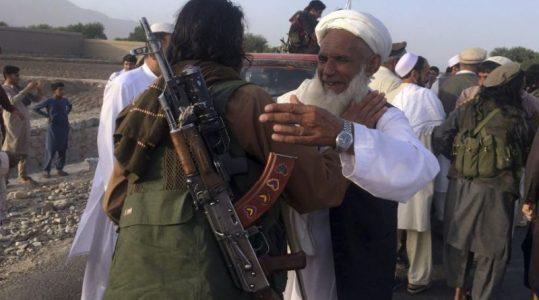
Taliban continues to host foreign terrorist groups
In its latest statement on the summit in Moscow, the Taliban stated “we do not allow anyone to use the soil of Afghanistan against other countries including neighboring countries.” Although the Taliban has employed similar language for years, it is a demonstrably false claim. The Taliban has continuously worked alongside jihadist organizations with regional and global aspirations, including al Qaeda.
Regardless, Zalmay Khalilzad, the US Special Representative for Afghanistan Reconciliation, seems eager to accept the Taliban’s assurances. After a round of talks in Doha in late January, Khalilzad claimed that “significant progress” had been made “on two vital issues: counter terrorism and troop withdrawal.”
Khalilzad clarified what he meant by “counter terrorism” during an interview with The New York Times. “The Taliban have committed, to our satisfaction, to do what is necessary that would prevent Afghanistan from ever becoming a platform for international terrorist groups or individuals,” Khalilzad said.
This is remarkably credulous. As Khalilzad himself said, no agreement is yet in place. Nor has the Taliban offered any renunciation of al Qaeda in public. Therefore, he must be accepting what he was told in Doha.
Moreover, the Taliban has lied about its role in sheltering al Qaeda and affiliated groups since well before the Sept. 11, 2001, hijackings. As the 9/11 Commission found, the Taliban told an American diplomat in Apr. 1998 that it didn’t know where Osama bin Laden was and, in any event, he wasn’t a threat to the United States. Four months later, on Aug. 7, 1998, al Qaeda operatives drove two truck bombs into the American embassies in Kenya and Tanzania.
The Taliban has harbored and collaborated with foreign terrorist organizations inside Afghanistan ever since, despite assurances to the contrary. Consider just one example. Days before the 2016 US Presidential election, the US killed Farouq al-Qahtani in eastern Afghanistan. Al-Qahtani not only worked with the Taliban to fight their common enemies inside the country, he was also overseeing al Qaeda plots targeting the West.
The Taliban and its many apologists would have us believe that figures such as Farouq al-Qahtani don’t really exist.
FDD’s Long War Journal has compiled data using press releases and public statements from the US military, NATO’s command in Afghanistan, and Afghan security services, as well as the jihadist groups’ own martyrdom statements. These data were then geotagged to a map (above) which tracks the terrorist groups’ operations and movement.
Data on the US-led coalitions’ raids begin in 2007, when the US military first released statements on operations targeting terrorist groups in Afghanistan. The most recent data point is in Nov. 2018, when a US soldier was killed battling al Qaeda in western Afghanistan’s Nimruz province. (Although the US military said the American soldier may have been killed in crossfire from Afghan forces, he was killed during a firefight with al Qaeda.)
The map documents operations against al Qaeda, the Movement of the Taliban in Pakistan (or Pakistani Taliban), the Islamic Jihad Union, the Islamic Movement of Uzbekistan, the Turkistan Islamic Party, Lashkar-e-Taiba, and generic “foreign fighters,” which often means al Qaeda but could include members of the other listed groups.
The data clearly show that al Qaeda and allied terrorist groups have been operating on Afghan soil for the past two decades with the approval of the Taliban. These terrorist organizations often operate in areas controlled by the Taliban. And the jihadists killed in coalition or Afghan raids often die alongside members of the Afghan Taliban.
Since 2007, NATO, US, and Afghan forces, have launched at least 373 operations against these foreign terror groups in 27 of Afghanistan’s 34 provinces. These numbers are merely a subset of the operations targeting foreign terrorist groups. Over the years, US military and intelligence officials have told FDD’s Long War Journal that many more raids against al Qaeda and its allies have gone unreported.
The data do not include operations against the Islamic State, as the Taliban violently opposes this rival terror group, and thus generally does not permit it to operate on its soil. (There have been reports of collusion between the Islamic State and the Taliban, but they frequently fight one another.)
Each of the groups identified on the map seeks to wage jihad in countries outside of Afghanistan, and they provide critical support for each other. Much of al Qaeda’s “General Command” — or senior management team — is based in the Afghan-Pakistan region. From there, the group directs, guides and support attacks around the globe. Its regional branch, al Qaeda in the Indian Subcontinent, operates in Pakistan, India, Bangladesh, and Burma.
The Pakistani Taliban has waged a bloody campaign inside Pakistan and sent an operative to bomb Times Square. The latter operation was reportedly planned in northern Pakistan, but the point is that the Pakistani Taliban operates in both countries. Both the Islamic Movement of Uzbekistan (IMU) and Islamic Jihad Union (IJU) seek to overthrow the Uzbek government. The Turkistan Islamic Party (TIP), which has fought alongside the Taliban since before the 9/11 hijackings, incites attacks in China, while also operating in Syria. A credible jihadi report in early 2018 indicated that the TIP had recently sent two leaders from Afghanistan to Syria, where they assumed control of the TIP’s branch in the Levant. The IMU, IJU, and TIP have also conducted attacks inside Pakistan. The IMU and IJU have been linked to terror plots in Europe. Lashkar-e-Taiba seeks to eject India from the state of Kashmir, and also has global ambitions. All of these groups cooperate and coordinate with al Qaeda. And all of these groups are allied with the Taliban.
It is not clear why anyone would accept the Taliban’s assurances regarding international terrorism at face value, when they’ve been lying all along.
Source: LWJ





